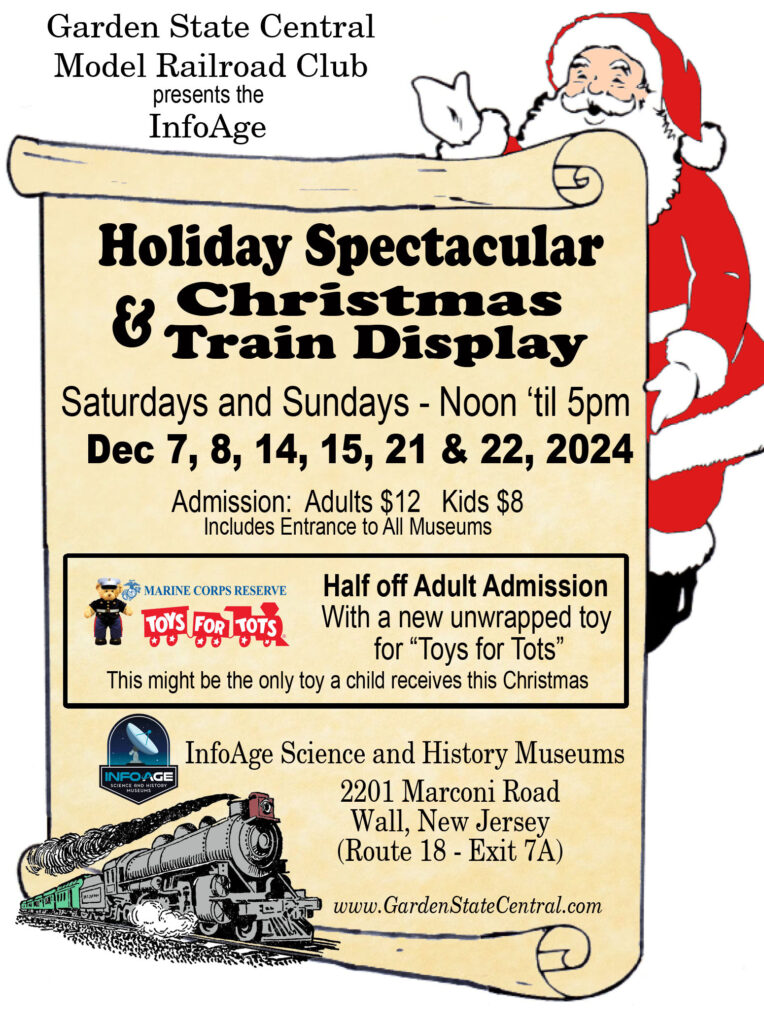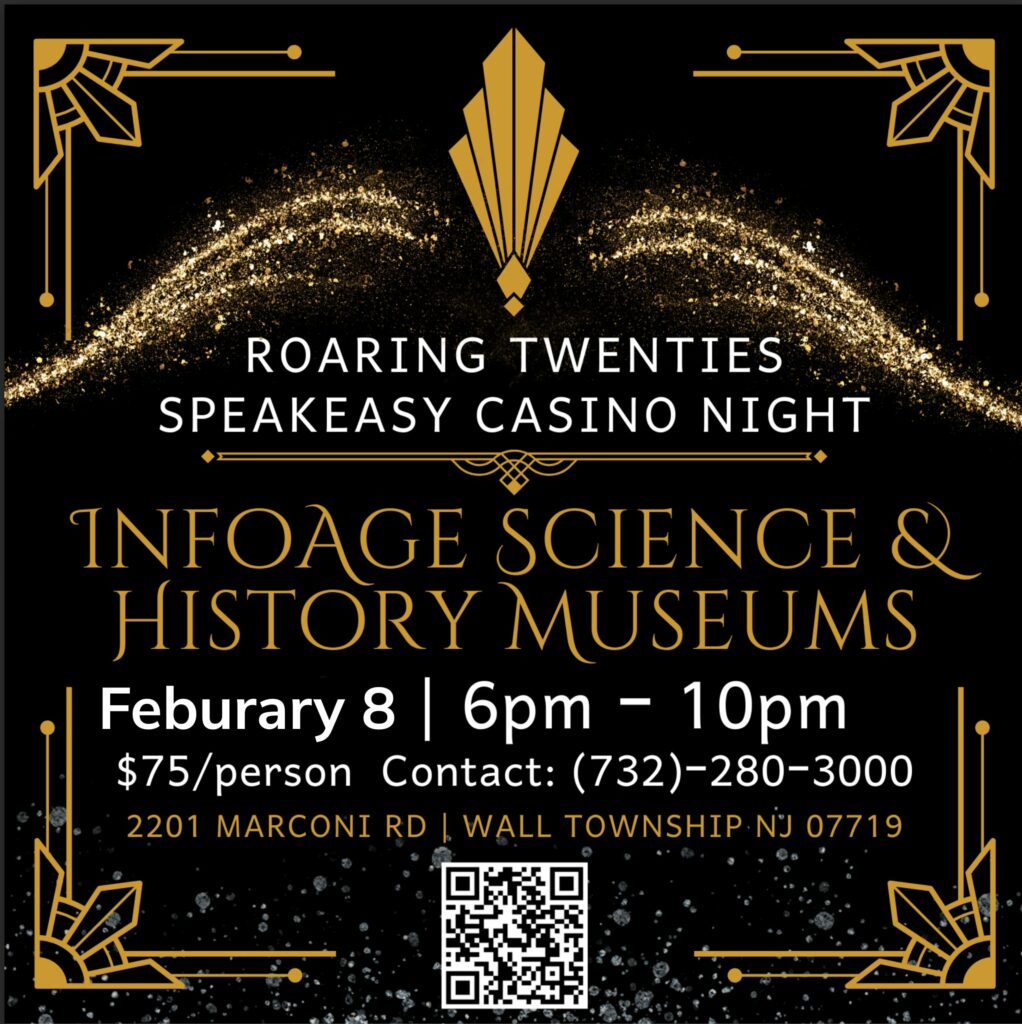The History of InfoAge Science & History Museums
Space Age - All About Radio and Television – Round Trip to the Moon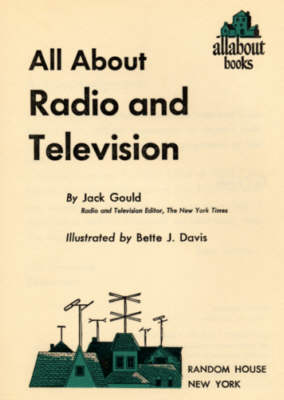
This 1958 copyright book by Jack Gould tells the story of radar and Project Diana to children. This is chapter 17 of the twelfth printing. The project Diana story is on page 138.
All About Radio and Television – Round Trip to the Moon
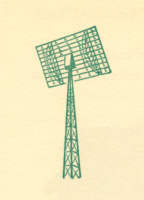
Radar Tower at Camp Evans
Ever since the beginning of time, man always has wished that he could see in darkness. Now he can through an invention that already has changed the course of history. It is the invention of radar. The word radar stands for Radio Detection and Ranging. “Detection” means to find out where something is, and “ranging” means to find out how far away that something is and, if it is moving, where it is going.
That is what radar does. It uses waves to go out into space and bring back a picture of what lies farther away than the eye can see. Darkness, fog, storm, and smoke screens do not affect these waves. The electronic “eyes” of radar are ready always to warn us of trouble ahead. It was radar that helped save England from the German airplanes during World War II. The Nazis sent swarms of planes over London in what is called “The Battle of Britain.” They hoped to crush the capital of the British Empire, which was then fighting almost alone, and to end the war quickly. England had only a few airplanes but very brave pilots.
With the help of radar, English airmen knew when Nazi planes were coming long before they reached London. With their few airplanes, they took off quickly and were in the sky when the Nazis arrived. Instead of finding London a defenseless city, the Nazis found the British ready for dogfights. After several raids, the Germans lost so many airplanes that the Nazi air force was never the same again. It was one of the turning points of the war.
Radar works like a rubber ball thrown against a stone wall.
If we throw a ball fast enough against a wall, we know that it will come right back to us like this:
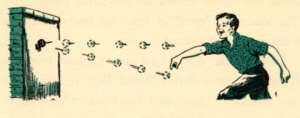
Now imagine that we knew how fast we threw the ball. Suppose we say that in one second the ball traveled ten feet. Let’s throw the ball against the wall a second time and have a friend hold a watch and tell us how long it takes the ball to make the round trip from your hand, up to the wall, and back again to your hand. Our friend looks at his watch and says the round trip took exactly two seconds. Now we can show what happened like this:
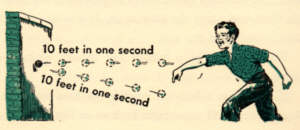
We know that in each second the ball can travel ten feet. Since it took two seconds for the round trip, that means the ball traveled a total of twenty feet. But we only want to know how far away the wall is from your hand. So we divide the round trip in half. Half of twenty is ten. So the distance from the hand to the wall is ten feet.
In radar, it is the wave that takes the place of the rubber ball. At a radar station, a transmitter and a receiver are put side by side. First, a signal-called a pulse-makes a wave that is sent out into the air from the transmitter. Then the transmitter is shut off, and the receiver is turned on. The signal goes out until it “hits” something like the stone wall-maybe it is a ship or maybe it is a plane. Then the signal bounces off the ship or the plane and comes back to the receiver. When it gets to the receiver, the signal goes to a picture tube and makes a tiny flicker of light.
We know a radio signal always travels at the same speed-186,000 miles a second. And we easily can tell how long the signal traveled. We measure the time between when it left the transmitter and when it came back to the receiver. So now we can tell how far the signal traveled. Just as we did with the rubber ball, we then divide that distance in half and we know how far away the plane is. We can show it like this:
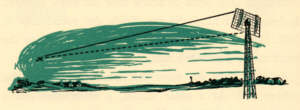
With a real radar set, all the calculations are done automatically. All the radar operator does is look at the picture tube, and he gets his answer right away. Because radio signals travel so much faster than the airplane, radar can follow the plane right across the sky. The face of the radar screen is divided into little squares. Then, on the screen, it shows where the plane is going to be in a couple of seconds like this:

If the plane is first spotted at A, we know it will soon be at B. This is time enough to aim and fire a shell from a gun if the plane is sent over by an enemy. The shell arrives at B just at the same moment as the plane. Down goes the plane in an explosion!
Another kind of radar sends out and receives a lot of waves. When enough waves are bounced back, it gives us a whole picture of what they have “hit,” like this:
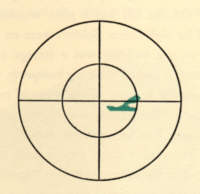
You can see how important radar is to ships and airplanes that must go through darkness, storms, and fogs. One ship can tell if another ship is crossing its path, or if there is an iceberg ahead. Radar is so sensitive that it can even pick out the conning tower of an enemy submarine. With radar, an airplane can tell if there is a mountain ahead, or if it is flying too close to the ground. Small radar sets are put in bombers and jet planes. With radar, although the bombardier often cannot see the target with his eye, he can put the bomb right where he wants it.
But the most dramatic story of radar took place on a lonely hill in New Jersey on a cold night in January 1946. On the hill was a plain wooden building surrounded by high fences. Soldiers were on guard. On top of the building was a strange rectangular piece of metal. It looked like a big bedspring, and it was pointed up to the heavens. It was a special radar aerial.
Inside the building, there were Army officers huddled over mysterious-looking radar sets. Everyone was very still. An hour after hour they waited. An officer finally looked at his watch. “All right,” he said. Suddenly there was heard in the room a signal that sounded like this:

Everyone held his breath and counted to himself
One
Two
They waited a fraction of a second more. Then they heard the sound that was to make history:
For the first time, the man had shown that he could “communicate” with the moon! The big “beep” was a radar signal sent up to the face of the moon. The little beep was all the strength that the signal had left after it had come back to earth like this:
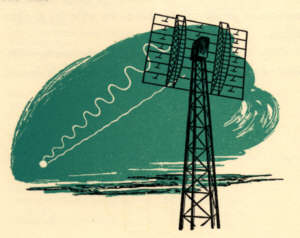
Twelve years later-in 1957-there were the more famous “beeps” heard around the world-the signals transmitted from Sputnik 1, the first man-made earth satellite. The inside of a satellite is crammed with electronic equipment. One nation can send up a satellite and it will pick up information about winds, temperatures and pressures in all parts of the world; the satellite can relay this information to earth each time it passes its starting point. Some day there will be cameras in the nose of space ships. Pictures of how the world looks from the outside will be transmitted to ground. And millions of people will be able to see what lies in outer space. Only sixty years ago-less than the average life-time of a person-radio and television were only dreams.
Page created September 02, 2000
We Need Your Help! Volunteer with Us.
Join our mission to preserve historic Camp Evans and teach the public about science and history.
Sign up to join our team of volunteers and start on your own mission today.
InfoAge Science & History Museums
2201 Marconi Road
Wall, NJ 07719
Tel: 732-280-3000
info@infoage.org
webmaster@infoage.org
